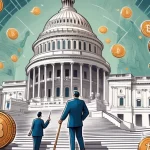XRP Spot ETFs on DTCC: Breakthrough for Crypto or Regulatory Trap?

Spot XRP ETFs Hit the DTCC List: A Turning Point for Crypto or a Regulatory Mirage?
Five spot XRP Exchange-Traded Funds (ETFs) from major players—CoinShares, Franklin Templeton, 21Shares, Canary Capital, and Bitwise—have surfaced on the Depository Trust & Clearing Corporation (DTCC) list, hinting at a U.S. market debut as soon as late November. This marks a long-overdue crack in the financial dam for XRP, Ripple’s native token, which has spent years tangled in regulatory drama but now seems poised for a shot at mainstream legitimacy.
- Major XRP ETFs Listed: CoinShares (XRPL), Franklin Templeton (XRPZ), 21Shares (TOXR), Canary Capital (XRPC), and Bitwise (XRP ETF) gear up for launch.
- Launch Timeline: ETF Institute’s Nate Geraci predicts some could go live within days, post-U.S. government shutdown.
- Market Surge: Record ETF launches and investor preference signal a ripe moment for crypto integration.
XRP’s Regulatory Redemption: From Lawsuit to Launchpad
The journey of XRP to this point reads like a courtroom thriller with a begrudgingly happy ending. For those new to the saga, Ripple, the company behind XRP, was slapped with a lawsuit by the U.S. Securities and Exchange Commission (SEC) in December 2020, alleging that XRP was an unregistered security—essentially, an investment contract sold without proper oversight. This legal battle dragged on for nearly five years, casting a shadow over XRP’s legitimacy and scaring off institutional interest. A partial victory came in July 2023 when a federal judge ruled that XRP sales on public exchanges didn’t constitute securities transactions, though Ripple still faced penalties for institutional sales. This resolution, finalized just three months ago, has seemingly unshackled XRP from its regulatory chains, opening the door for products like spot ETFs.
Spot ETFs, for the uninitiated, are investment funds traded on stock exchanges that directly track the real-time price of an asset—in this case, XRP—unlike futures ETFs which speculate on future values. Their listing on the DTCC, a key registry for financial products, signals that these funds are either active or in pre-launch status, awaiting final SEC nods. The removal of delay clauses in S-1 filings—formal documents submitted to the SEC to register new investment products for public trading—further fuels optimism that approvals are imminent. Add to that the recent end of a U.S. government shutdown, a bureaucratic snag that delayed countless financial rollouts, and the stage seems set for action. If you’re curious about the specifics of these listings, check out the details on the recent XRP ETF appearances on the DTCC roster.
Nate Geraci, co-founder of the ETF Institute, isn’t mincing words about the timeline or the broader implications. He’s betting on launches within the next two weeks, potentially as early as this week, and sees this as a symbolic middle finger to the anti-crypto stance of past regulators.
“Sometime in the next two weeks, I expect the launch of first spot xrp ETFs…SEC had open litigation against Ripple for the past five years, up until three months ago…IMO, launch of spot xrp ETFs represents final nail in coffin of previous anti-crypto regulators.” – Nate Geraci, Co-founder of the ETF Institute
But let’s not pretend the SEC’s suddenly a crypto cheerleader. Their track record of stonewalling digital asset products means last-minute hurdles could still trip up these launches. The agency’s history with XRP is a bitter one, and even with legal clarity, bureaucrats have a knack for dragging their feet. Hell, they’ve spent years playing whack-a-mole with anything blockchain-related—don’t expect them to roll out the red carpet now.
Key Players and Products: Who’s Betting Big on XRP?
The lineup of firms jumping into the XRP ETF fray is a who’s who of financial and crypto heavyweights. CoinShares is pushing its XRPL ETF, Franklin Templeton has the XRPZ ready to roll, 21Shares is behind TOXR, Canary Capital is gearing up with XRPC, and Bitwise keeps it simple with their XRP ETF. Each brings a unique angle to the table—Franklin Templeton, for instance, is no stranger to innovation, having dipped into blockchain funds before, while Bitwise has built a reputation for crypto-native investment products that resonate with digital asset enthusiasts.
Canary Capital’s move stands out, filing with the SEC on November 8 to list on Nasdaq. They’ve tapped Gemini and BitGo as custodians—specialized firms that securely store and manage digital assets like XRP for funds and investors—names that carry serious cred for their robust security protocols in a space notorious for hacks. Meanwhile, REX-Osprey’s XRPR ETF is already trading in U.S. markets, proving there’s real demand for XRP exposure through regulated channels. These aren’t fly-by-night operations; they’re calculated plays betting on XRP’s rebound.
Diversified crypto funds are also throwing weight behind XRP. WisdomTree’s filing for a CoinDesk 20 ETF—a diversified fund tracking the top 20 digital currencies by market value, as ranked by CoinDesk, a leading crypto data provider—allocates a hefty 19.6% to XRP. That’s not pocket change; it signals institutional confidence that XRP isn’t just a speculative token but a cornerstone of the digital asset landscape. Could this be the moment XRP sheds its bad-boy rep and gets taken seriously?
The ETF Market Boom: A Perfect Storm for Crypto
While XRP ETFs are grabbing headlines, the broader ETF market is experiencing a downright explosion. October alone saw a record 136 ETF launches across all asset classes, a testament to their growing appeal. But it’s not all sunshine—Roundhill CEO Dave Mazza warns that smaller issuers are getting chewed up in what he calls a “Terrordome” of competition, lacking the muscle of giants like Franklin Templeton to survive the cutthroat landscape. For some of these XRP ETFs, especially from lesser-known players, the road to market could end in a brutal knockout.
A Charles Schwab study hammers home why ETFs are becoming the darling of investors. Their data shows 62% of surveyed investors can envision all-in ETF portfolios, with half expecting to get there within five years. Two-thirds jumped into ETFs in just the past five years, lured by dirt-cheap fees (a priority for 94%) and access to offbeat asset classes like crypto (noted by 46%). For the crypto crowd, this is huge—ETFs offer a sanitized entry point to digital assets without the Wild West chaos of managing wallets or dodging shady exchanges. Spot XRP ETFs could be the bridge that brings hesitant capital off the sidelines.
Risks on the Horizon: Not All Glitter Is Gold
Before we get too drunk on optimism, let’s sober up with some hard truths. Regulatory uncertainty still looms large. The SEC might have lost its biggest battle with Ripple, but they’re not above petty delays or reinterpretations of “clarity.” XRP’s legal baggage could still spook risk-averse investors or trigger last-second roadblocks. And let’s not forget market risks—XRP’s price volatility and relatively niche use case compared to Bitcoin or Ethereum could dampen ETF inflows if sentiment shifts.
Then there’s the ideological clash. Bitcoin maximalists—and I lean that way myself—often sneer at XRP as a “banker’s coin” due to Ripple’s cozy ties with financial institutions. To purists, XRP’s centralized design, with Ripple controlling a massive chunk of the token supply, is anathema to the decentralized ethos of crypto. Sure, ETFs might drive awareness and adoption, but do they also dilute what makes blockchain revolutionary? Are we trading financial freedom for Wall Street’s stamp of approval? It’s a bitter pill to swallow, even if the pragmatist in me sees the necessity of regulated on-ramps to scale this movement.
Smaller ETF issuers face their own gauntlet. As Mazza pointed out, the competitive landscape is unforgiving. If a smaller player like Canary Capital can’t match the marketing or fee structures of a Bitwise, their XRP ETF could flop before it even gains traction. We’ve seen this before—promising funds launch with fanfare, only to wither under the weight of giants. Not every ticker on the DTCC list is guaranteed a happy ending.
XRP ETFs vs. the Altcoin Ecosystem: A Broader Perspective
XRP isn’t the only altcoin eyeing ETF glory. Ethereum spot ETFs are already making waves, offering exposure to a blockchain with smart contract dominance—something XRP doesn’t compete with directly. Other altcoins, from Cardano to Solana, have their own ETF whispers, each filling niches Bitcoin doesn’t touch. As much as I champion Bitcoin’s unrivaled security and decentralization, I can’t ignore that altcoins like XRP cater to specific use cases—cross-border payments, in XRP’s case—that Bitcoin isn’t optimized for. ETFs for these assets could diversify crypto’s institutional footprint, even if they don’t dethrone the king.
Still, XRP’s journey feels uniquely contentious. Unlike Ethereum, which dodged much of the regulatory heat, XRP’s battle scars make its ETF push a litmus test for how far crypto can infiltrate traditional finance. If these funds succeed, they could pave the way for a flood of altcoin ETFs. If they flop, expect regulators to tighten the screws on anything that isn’t Bitcoin.
What This Means for Crypto’s Future
As a staunch advocate for decentralization and financial sovereignty, I’m torn on XRP ETFs. On one hand, they’re a battering ram against the old financial guard, forcing stodgy institutions to reckon with blockchain’s staying power. If launched, they could funnel billions into crypto from investors who’d never touch a hardware wallet, accelerating adoption at a pace raw decentralization alone can’t match. On the flip side, regulated vehicles like ETFs risk taming the wild spirit of crypto, wrapping it in suits and SEC filings until it’s just another asset class for hedge funds to exploit.
Yet, I lean toward effective accelerationism here—pushing forward, flaws and all, because stagnation is death. XRP ETFs, for better or worse, are a step toward dismantling centralized financial control, even if they come with compromises. The data backs the momentum: XRP’s market cap has stabilized post-lawsuit at around $30 billion as of late 2023, and analyst predictions of ETF inflows ranging from $500 million to $1 billion in the first year suggest serious potential. But the question lingers—will these ETFs truly democratize finance, or just hand crypto’s rebellious soul to Wall Street on a silver platter?
Key Questions and Takeaways for Crypto Enthusiasts
- What’s behind the surge of spot XRP ETFs in the U.S.?
The end of Ripple’s five-year SEC lawsuit in 2023, streamlined S-1 filings signaling near-certain approvals, and the lifting of a government shutdown have fast-tracked potential launches for late November. - How significant is XRP in diversified crypto investment funds?
XRP holds a substantial 19.6% slice in WisdomTree’s CoinDesk 20 ETF, reflecting strong institutional belief in its role among top digital assets. - Why are crypto ETFs becoming a go-to for traditional investors?
Charles Schwab’s research points to low fees and access to unique markets like crypto as major draws, providing a safer way to invest without the hassle of direct ownership. - What specific risks threaten XRP ETF success?
Beyond SEC delays, XRP’s centralized structure and Ripple’s banking connections could turn off decentralization purists, while smaller issuers risk being steamrolled by bigger competitors. - Do XRP ETFs align with the vision of financial freedom?
They challenge traditional finance by bringing crypto to the masses, but their regulated nature sparks debate over whether they undermine blockchain’s core ethos of rebellion and autonomy.



